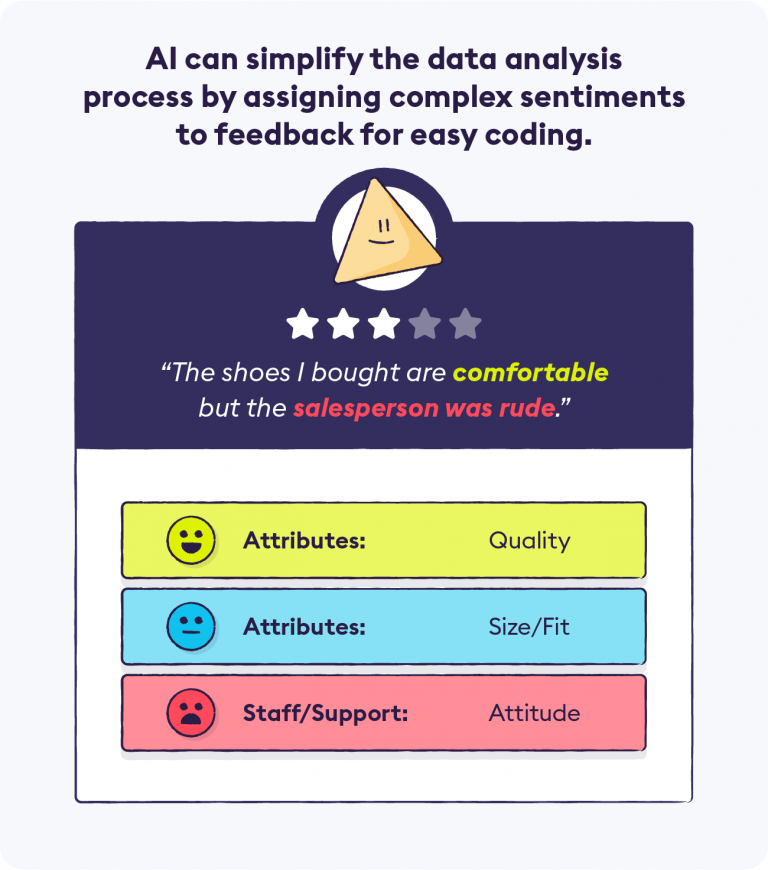If you’re running an e-commerce business, you’re likely using e-commerce analytics. E-commerce analytics is the process of collecting and analyzing a plethora of data from multiple areas of your online business.
With this data, you can better understand your customers’ behavior. You can discover where they’re churning and why or perhaps which products or services sell best.
By increasing your e-commerce analytics, you can address and fix pain points at any stage of the customer journey. You can also develop your target audience, marketing, advertising, sales, and PR strategies based on the feedback received from the analytic reports.
One key analytic within e-commerce analytics is sentiment analysis. This technology allows you to grab a hold of all online thoughts and reviews from your customers and compress that information into both quantitative and qualitative data.
With text analytics and sentiment analysis technology, you can easily quantify your customer’s feedback from online reviews, surveys, or social media posts.
The below guide will define both text analytics and sentiment analysis and how they give key insight into your company’s e-commerce analytics and how to adjust your e-commerce business model and strategies based on the received information.
What is Sentiment Analysis?
Sentiment analysis is a cutting-edge AI language processing technique. It will assign a weighted “sentiment” score to elements of text from a customer. Normally, the text will then be graded as positive, negative, or neutral. Part of having a successful sentiment analysis tool means having a great text analytics tool. In fact, sentiment analysis cannot exist without text analytics.
What is Text Analytics?
Text analytics is the machine learning component of sentiment analysis. It’s the process or technology used to turn online reviews, opened-ended answers from surveys, social media comments, and other qualitative feedback into quantitative data.
A sentiment analyzer takes this quantitative data and finds patterns in sentences which then gets processed to become sentiment analysis. Check out this text analytics tool from Chattermill.
Both sentiment analysis and text analytics together give companies essential insight that they otherwise wouldn’t be able to obtain.
For example, HelloFresh, a D2C food delivery service, used sentiment analysis to better understand their consumers’ preferences, dislikes, and overall needs. HelloFresh created a story brand for their child consumers. HelloFresh discovered that children avoided their casserole recipes because they couldn’t easily identify what was in their food due to the images used on the packaging and the ingredient list. HelloFresh then modified their recipes and packing to be more transparent about which ingredients are within their casserole dishes.
Example of Sentiment Analysis
Let’s say that your business receives a large number of online reviews on Google, Yelp, and other online review spaces. A sentiment analysis program can detect patterns of specific words and phrases from these reviews and connect these feelings or sentiments to the object being repeatedly discussed.
Let’s say that a large portion of clients are saying they love a product and have little to no issues with it. Unfortunately, many didn’t like their online shopping experience due to slow page speed or a difficult checkout process.
The sentiment analysis tool would mark the overall sentiment towards the product as positive but would indicate that the online shopping experience is negative — particularly the page speed and checkout process.
With sentiment analysis, companies can gain insight into how customers specifically perceive them, a product, and their services. Companies can pinpoint particular interactions that are influencing customer sentiment and therefore their satisfaction.
4 Sentiment Analysis Types
There are four types of sentiment analyses. Depending on your e-commerce business’ goals, sentiment analysis can focus on polarity (positive, negative, neutral), emotions (irritation, satisfaction, relief), or intention (interest level, purchase, or churn).
Fine-Grained Sentiment Analysis
Fine-grained sentiment analysis is the most popular form and is what we’ve been referring to so far. Fine-grained sentiment analysis examines a buyer’s polarity and simply grades their feelings as neutral, positive, or negative.
If more granular feedback is needed, consider expanding the Likert scale to measure great, good, neutral, bad, very bad instead of just neutral, positive, or negative.
Emotion Detection
Emotion detection sentiment analysis is one of the more advanced forms of text analytics. Emotion detection recognizes emotions such as anger, frustration, irritation, regret, satisfaction, etc.
To successfully implement emotion detection, a sentiment analysis tool uses a lexicon (list of words and their corresponding emotions). It uses this lexicon with complex machine learning algorithms to determine the meaning behind words.
Let’s say a customer left this open-ended response to a customer satisfaction survey:
“The customer service team took too long. I had to be unnecessarily transferred to multiple people.”
The emotion detection sentiment analysis would be able to pick up on the phrases, “took too long” and “unnecessarily transfer to multiple people.” It would then decipher that the customer’s issue took too long and they were irked at having to be transferred to multiple customer representatives.
If a similar pattern persists from other clients, then an e-commerce company would know they need to install omnichannel support in the CX department.
Aspect-Based Sentiment Analysis
Aspect-based sentiment analysis is most often used when analyzing product reviews. This is especially helpful for e-commerce brands. Aspect-based sentiment analysis helps e-commerce businesses learn more about a specific aspect or feature of their product.
For instance, an aspect-based classifier can help determine that this text, “the shoes are very comfy but the back of the sole is quickly deteriorating” denotes a positive opinion about the comfort, but a negative or frustrating evaluation about the shoe’s sole.
Intent Analysis
Intent analysis identifies the overall goal or objective of a customer. For example, an intent analysis program can determine if an email or online message from a customer is a query, suggestion, complaint, or simply a sign of gratitude and appreciation. Knowing the intent can help automate the CX process and quickly direct the customer to the best representative.
An intent analysis is quite useful for e-commerce businesses looking to enhance their digital marketing skills.
Here’s an example: Multiple clients or consumers from a shoe company comment on social media or in online forums that they loved their first pair of shoes, and are looking for another due to normal wear and tear.
The e-commerce shoe company’s marketing and advertising teams can create campaigns around an upcoming product launch and can post some of these positive reviews to build excitement.
In Conclusion
In summary, sentiment analysis and text analytics used together create a powerful tool that allows e-commerce businesses to gain key insight into how their customers feel and view a specific product, service, or the business in general.
By having this knowledge, e-commerce companies can make more strategic and better marketing, CX, and business decisions.

This was a guest post by Chi Whitley
Chi is a content creator and blog writer based in Austin, TX. He writes well-written articles for several B2C and B2B clients. When he’s not writing or brainstorming SEO-backed ideas, you can find him outside playing frisbee or walking his dog, Augie.


